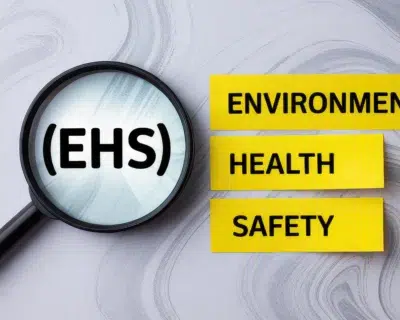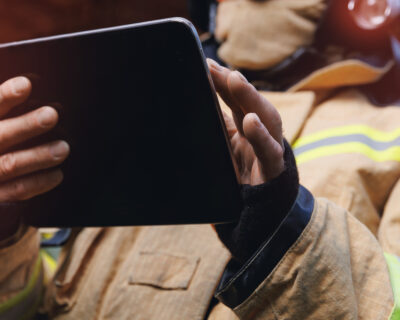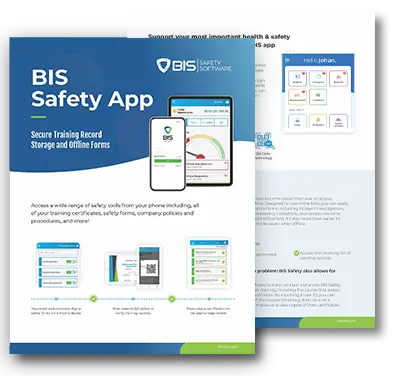
Lithium Battery Safety in the Workplace
Lithium batteries have become embedded in our daily lives, present in various devices such as cell phones, power tools, electric bikes, scooters, vaping products, cameras, vacuums, solar battery systems, and many more! However, what many people may not realize is that these batteries pose more dangers than commonly perceived. The rising use of lithium batteries has led to an increase in fires, particularly in homes and workplaces.
Incidents involving lithium battery fires, especially in e-bikes, electric vehicles, laptops, and vaping products during air travel, have garnered significant attention in the last couple of years. This heightened awareness has contributed to a need to educate workplaces understanding of the risks associated with lithium batteries. The need to mitigate these risks and eliminate potential dangers has become crucial considering their widespread use as a portable energy storage solution.
Battery Incidents
Batteries–particularly Lithium batteries–have made the news in multiple ways lately but we need to focus on safety which means we need to be aware of the risk associated with these stored energy packets. Let’s look at the dangers of batteries before we discuss ways of mitigating the risks:

- Electronic Devices (Smartphones, Laptops, etc.): Lithium-ion batteries are commonly used in portable electronic devices. Overheating or manufacturing defects can lead to fires in devices like smartphones and laptops.
- Electric Vehicles (EVs): Lithium-ion batteries power electric vehicles, and although incidents are rare, there have been cases of electric car fires, sometimes associated with battery malfunctions or accidents.
- E-bikes and Hoverboards: Electric bikes (e-bikes) and hoverboards often use lithium-ion batteries. Issues such as overcharging, poor battery quality, or manufacturing defects can lead to fires.
- Air Travel: Lithium battery fires on airplanes have raised concerns. Overheating or damage to batteries in electronic devices carried by passengers can potentially lead to fires on board.
- Consumer Products and Toys: Various consumer products, including power tools, toys, and gadgets, use lithium batteries. Poorly designed or defective products may pose a fire risk if the batteries are not handled properly.
- Waste & Recycling Facilities: In waste and recycling facilities, lithium-ion batteries pose a fire risk when improperly disposed of. Damage to batteries during the disposal process can lead to hazardous situations, emphasizing the need for proper handling and disposal procedures.
With just a few searches, you can easily discover numerous fires caused by lithium batteries. Here are a few instances:
- A lithium-ion battery attached to a cordless impact wrench exploded after it was left on the back seat of a vehicle over a weekend. The power tool was left in the interior of a hot vehicle.
- In 2024, a lithium-ion battery failure powering an e-bike caused a blaze aboard a subway train, emphasizing the rapid spread of flames from faulty batteries. (article: subway fire)
- A hotel fire in Canada’s second floor, caused by an exploding battery, highlighted a 500% increase in fires linked to lithium-ion batteries since 2016, according to the city’s fire service public information officer. (article: exploding battery)
- Lithium-ion batteries emerged as a leading cause of fatal fires in the state, resulting in 13 fatalities by July 2023 (article: fatal fires in New York)
- A lithium battery caused a five-alarm fire at a recycling plant in Queens, contributing to an increase in garbage facility fires. The U.S. and Canada face the reality of potential fires in over 10,000 facilities.
- A lithium battery in a child’s toy exploded while it was charging.
- On an airline lithium battery in a personal device caught fire in an overhead bin. Incidents of overheated lithium batteries on aircraft are now happening at a rate of more than one per week, on average. Most of these incidents were caught early and resulted only in a short flight delay. (article: FAA concerns)
Growing Concerns
- In 2023, the International Association of Fire Chiefs and other partnering agencies held a firefighter safety stand-down week focused on responder safety in lithium-ion battery incidents. (article: Fire Fighter safety stand down)
- Lithium-ion batteries pose concerns for airlines, prompting Transport Canada to release an education campaign to address safety risks associated with these batteries. (article: Transport Canada)
- In July 2023, The FAA (Federal Aviation Administration) released a podcast, “Fly Safe With Lithium Batteries (article: Fly Safe With Lithium Batteries | Federal Aviation Administration (faa.gov)
- The Environmental Protection Agency (EPA) released a report on lithium fires in waste and recycling facilities, emphasizing additional risks landfill workers face and potential service disruptions. 390 waste and recycling facility fires in the U.S. and Canada in 2022. 65% battery related fires. (article: EPA Report)
- According to the Electrical Safety Foundation (ESFI), there is an increased number of home fires and electrical accidents during the winter holiday season, resulting in seasonal campaigns to heighten awareness of potential risks.
- U.S. Consumer Product Safety Commission reported that there were more than 25,000 issues involving fires or overheating stemming from lithium-ion batteries in a five-year period since 2016.

Why Are Lithium Batteries More Dangerous Than Regular Alkaline Batteries?
Lithium batteries are considered more dangerous than alkaline batteries due to their chemical composition, as lithium reacts violently with moisture or air, potentially leading to fire and explosion hazards. Additionally, lithium-ion batteries, commonly used in portable electronic devices, contain flammable materials, making them more prone to severe outcomes in the event of a fire.
Safety Concerns:
- React violently with moisture, water, or steam, producing flammable hydrogen gas and toxic lithium hydroxide.
- Classified as dangerous goods in both Canada and the USA.
- Prone to thermal runaway triggered by factors like overheating, damage, or improper charging.
Thermal Runaway Challenges:
- Difficult to detect and stop once initiated.
- Can be induced by exposure to high pressure or physical damage.
- Reignition is common and can occur unexpectedly after a visible fire has been extinguished.
Fire Challenges:
- Difficult to extinguish, particularly due to the reaction with water.
- Ignition can happen when devices are not in use or stored improperly.
Overcharging Risks:
- Overcharging can create excessive heat, leading to thermal runaway.
- Incompatible or damaged chargers can make the battery unstable.
Fire Hazards in Use and Storage:
- Fires can occur if the batteries are damaged and exposed to air or other metals.
- Lithium-ion batteries may ignite even when not in use.
- Reignition risk exists minutes, hours, or days after visible fire extinguishment.

With So Many Risks You May Be Wondering Why Not Use Other Batteries?
- Other rechargeable battery types do exist and are widely used however, lithium-ion batteries are more useful and therefore much more popular as they combine fast charging, long charge holding and high power density, for more battery life in a smaller package.
- They’re lighter than alkaline batteries, so they offer an advantage when used with portable devices, especially cordless power tools.
- Lithium batteries are designed to last longer, making them a good choice for high-tech and smart devices, and those electronics for which changing the battery is inconvenient.
- They can withstand extremely low temperatures so they can work without failing in a freezing climate. This makes them ideal for outdoor applications.
- Lithium Battery and a Lithium-Ion Battery, Lithium batteries, on the other hand, are disposable and should never be recharged. Lithium-ion batteries (sometimes referred to as li-ion batteries) can be recharged and reused.
Workplace Practices and Controls for Lithium Batteries
Lithium batteries are generally safe, but defects or damage can pose fire and explosion risks, emphasizing the importance of understanding warning signs to prevent catastrophic incidents. The level of controls for workers handling lithium batteries depends on the workplace and battery types, with examples including PPE, emergency response, and safe handling measures. Implementing controls in the use, handling, storage, and disposal of lithium batteries is crucial for workplace safety.
Personal Protective Equipment (PPE)
- Eye protection involves using safety glasses or goggles to shield the eyes from splashes, sparks, or debris during battery handling. Additionally, a face shield provides extra protection against impact or splashes to the face.
- Hand protection is ensured using gloves, offering chemical resistance, and safeguarding hands from contact with electrolytes or harmful substances.
- Clothing plays a crucial role, with heat-resistant, chemical-resistant coveralls protecting the body from exposure to chemicals. In scenarios where thermal events are a risk, flame-resistant clothing provides additional protection.
- Respiratory protection is required to guard against the inhalation of particulates or fumes that may be generated during battery handling.
- Foot protection involves wearing chemical-resistant, closed-toe shoes, providing a shield for the feet against spills and potential exposure to hazardous materials.
- Tools used in handling lithium batteries should be plastic or insulated, such as insulated screwdrivers and tools, to reduce the risk of short circuits or electrical contact.
Emergency Response
- Use sand or mineral oil, or a dry chemical fire extinguisher and lithium-based fire suppressant blanket nearby.
- Maintain your emergency response plan by regularly updating it with specific details related to lithium batteries, including information on extinguisher types, their locations, storage guidelines, and comprehensive coverage of scenarios such as fires, leaks, or overheating.
- Ensure the first aid kit has sufficient supplies for potential chemical burns related to lithium batteries.
- Provide specialized training to emergency responders, like firefighters and hazmat teams, focusing on the unique hazards of lithium batteries.
- Designate specific areas for isolating and containing potential hazards associated with lithium batteries.
- Establish clear evacuation plans in case of a lithium battery fire to ensure everyone’s safety.
- Install appropriate fire suppression equipment, eyewash stations, and emergency showers.
- Have a lithium response spill kit that contains non-conductive tools, metal bin and neutralizing agents like dry sand or powder to handle spilled batteries.
Handling
- Inspect batteries for damage, swelling, cracking, or leaking regularly.
- Use the charger that came with the device and unplug it if the device becomes excessively hot during charging.
- Charge and store batteries in a fire-retardant container designed for lithium-based batteries.
- Be alert to odd odors, discoloration, excessive heat, changes in shape, leaking, smoking, or failure to hold a charge, as these could indicate potential danger.
- Handle with care, as contact can severely irritate and burn the skin, eyes, nose, and throat.
- When working with smartphones and tablets, use plastic tools instead of metal ones to reduce the risk of battery puncture.
- Workers who regularly use or handle lithium-powered devices, especially those worn close to the body like small cameras worn by police and security personnel, are at increased risk of burns or serious injury if a lithium battery catches fire or explodes.
Storage
- Store lithium batteries in a cool, dry place, avoiding open areas with direct sunlight or hot surfaces.
- Use metal bins to isolate lithium batteries from bulk storage and workspace areas.
- Ensure storage away from combustible materials to minimize fire risks.
- Keep a log of disposed devices for emergency situations, providing crucial information for fire departments.
- Inspect batteries before storage and regularly while in storage before disposal to detect any potential changes in their state.
- Adhere to classification guidelines for storage and handling outlined in Transportation of Dangerous Goods and Hazardous Materials regulations.
- Use a battery organizer for proper storage, keeping batteries in their original packaging or protective cases.
Proper Disposal
- Do not throw lithium batteries in the trash; it may be illegal in certain regions. Bring them to a recycling facility.
- Check with local agencies and waste collection organizations for guidance on recycling facilities for lithium batteries.
- Single-Use Alkaline Batteries such as AAA, AA, and 9-volts, tape up the ends with electrical tape to prevent contact.
- Keep original battery packaging for proper disposal.
- Some battery types may have terminal covers; use them for added safety.
Education and Training
- Provide general awareness training to personnel about the characteristics, hazards, safe handling, PPE use, storage, and disposal procedures of lithium batteries.
- Educate employees on emergency response protocols in the event of fires, leaks, or other incidents involving lithium batteries.
- Familiarize personnel with relevant regulations and standards governing the transportation, storage, and disposal of lithium batteries.
- Instruct on regular maintenance and inspection practices to identify potential issues with lithium batteries before they escalate.
- Offer first aid training specific to lithium battery incidents, covering responses to chemical burns, exposure, or other related injuries.
- Include a lithium-based response drill in your emergency planning to ensure practical readiness in handling battery-related emergencies.
- Perform regular inspections, educate findings, and provide recommendations to improve lithium battery safety measures.
- Review near misses and safety incidents, both within your organization and others, to identify lessons learned and enhance safety protocols.
- Research stories or examples related to lithium battery incidents that can be shared within the organization, fostering a culture of awareness and prevention.
Summary
Organizations can enhance safety with a proactive approach to lithium and other battery hazards, implementing proper controls, updating safety protocols, and providing education and training. These measures encompass fire suppression, first aid, containment, and effective emergency response planning. Integration of lithium battery training into workplace safety practices promotes continuous learning and a proactive safety culture. Adherence to industry guidelines, manufacturer recommendations, and workplace safety protocols is crucial, and regular training and awareness efforts are essential for accident prevention. Seeking guidance from safety professionals and collaborating with health and safety teams further ensures accurate advice and tailored safety measures.
Contact us today to learn more about how our inspection tools, education programs and safety system can help you manage your safety programs.




































